Worksheet Solutions: Methods of Separation in Everyday Life - 2 | Worksheets with Solutions for Class 6 PDF Download
| Table of contents |

|
| True or False |

|
| Match the Following |

|
| Fill in the Blanks |

|
| Assertion and Reason Questions |

|
| Answer the following |

|
True or False
(i) The property used in separating a mixture of two solids by winnowing is the difference in weight.
Ans: True
Winnowing separates lighter components like husk from heavier grains using wind or air.
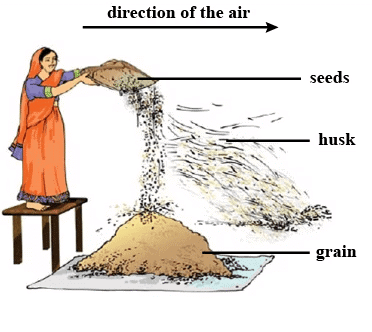 Winnowing
Winnowing
(ii) A mixture of milk and water can be separated by filtration.
Ans: False
Filtration is ineffective for separating milk from water since both are liquids and the particles are too small.
(iii) A mixture of powdered salt and sugar can be separated by the process of winnowing.
Ans: False
Winnowing is used for separating components with significant differences in weight, which is not applicable to salt and sugar.
(iv) Separation of sugar from tea can be done with filtration.
Ans: False
Sugar dissolves in tea, so filtration cannot separate it.
(v) Grain and husk can be separated with the process of decantation.
Ans: False
Decantation separates solids from liquids, while grain and husk are separated by winnowing.
(vi) Sieving is used when the components of the mixture are of different sizes.
Ans: True
Sieving separates components based on size, like separating bran from flour.
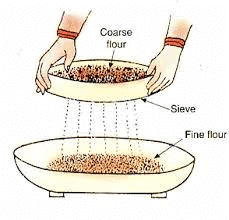 Seiving
Seiving
(vii) The method of filtration is also used in the process of preparing cottage cheese in homes.
Ans: True
Filtration separates solid paneer from liquid whey during the preparation of cottage cheese.
(viii) Hand-picking can be used to separate cashew nuts from a mixture of almonds and cashew nuts.
Ans: True
Hand-picking is effective for separating larger, easily distinguishable items like nuts.
Match the Following
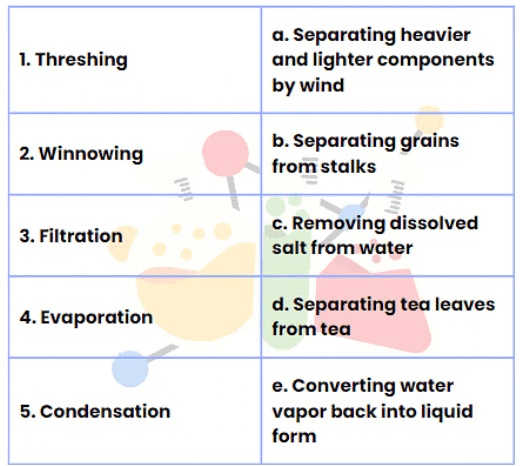
Ans: Here is the correct matching for the provided options:
- Threshing - b. Separating grains from stalks
- Winnowing - a. Separating heavier and lighter components by wind
- Filtration - d. Separating tea leaves from tea
- Evaporation - c. Removing dissolved salt from water
- Condensation - e. Converting water vapor back into liquid form
This matches the different separation techniques with their correct descriptions.
Fill in the Blanks
(i) The process of separating a liquid from solid sediment is called .
Ans: decantation
(ii) The method of separating seeds of paddy from its stalks is called .
Ans: threshing
(iii) When milk, cooled after boiling, is poured onto a piece of cloth, the cream (malai) is left behind on it. This process of separating cream from milk is an example of .
Ans: filtration
(iv) Salt is obtained from seawater by the process of .
Ans: evaporation
(v) is used to remove impurities and bran from the flour.
Ans: Sieving
(vi) We see water drops under the plate that has been used to cover a container containing milk that has just been boiled. This is due to the process of .
Ans: condensation
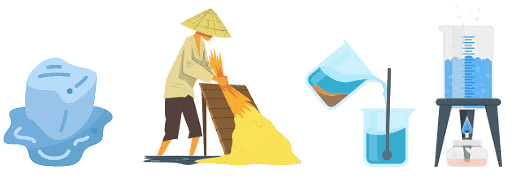
Assertion and Reason Questions
Q4: Assertion (A): The process of settling of heavier insoluble particles from a suspension of a substance in water known as decantation.
Reason (R): The Decantation process, along with sedimentation, is used to get clear water from muddy water.
(a) Both A and R are true, and R is the correct explanation of A.
(b) Both A and R are true, but R is not the correct explanation of A.
(c) A is true, but R is false.
(d) A is false, but R is true.
Ans. (d)
The assertion states that the process of settling heavier particles in water is called decantation, but this is incorrect. The correct term for settling heavier particles is sedimentation. Decantation is the process of carefully pouring off the clear liquid after sedimentation.
The reason (R) is true because sedimentation and decantation are used together to get clear water from muddy water.
Since the assertion is false and the reason is true, the correct answer is (c).
Answer the following
Q5: Write any two methods used for the separation of substances.
Ans: Hand-picking and Threshing
Q6: How can we separate sand from water?
Ans: We can separate sand from water by using sedimentation to let the sand settle at the bottom, followed by decantation to pour off the clear water.
Q7: Which method would you prefer to separate a solid dissolved in a liquid?
Ans: Evaporation
Q8: The Filtration method is used to separate tea leaves from prepared tea. Which other method can be used?
Ans: Decantation
Q9: List various methods of separation of components from their mixtures.
Ans: Some of the methods are: handpicking, winnowing, threshing, sedimentation, decantation, filtration, evaporation and condensation.
Q10: The process of adding alum to water to fasten sedimentation is called loading. Why has this name been given to the process
Ans: The term "loading" is used because adding alum makes the suspended particles heavier, causing them to settle faster.
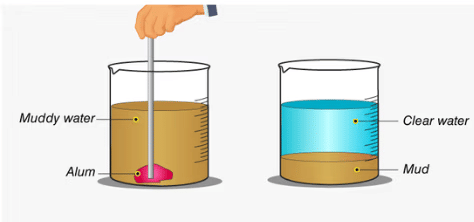
Q11: Why is sieving not used to separate very small stones from rice grains?
Ans. Sieving is not used to separate very small stones from rice grains because both are of almost the same size and both will pass through the holes of the sieve.
Q12: What is winnowing? Where is it used?
Ans: Winnowing is the method in which heavier components of the mixture are separated from the lighter components such as chaff, dirt, etc. by dropping the mixture from height into the air. This method is used by farmers to separate husk and other lighter impurities from grains.
Q13: Why do we separate substances?
Ans: We need to separate the components of a mixture for the following reasons:
- To separate two different but useful components from the mixture.
- To remove non–useful components from the mixture.
- To remove impurities or harmful substances from the mixture.
- To remove the unwanted impurities from the mixture.
- To obtain pure substances by removing the other substances.
Q14: How will you separate husk or dirt particles from a given sample of pulses before cooking?
Ans: Husk or dirt particles from a given sample of pulses can be removed by washing the pulses with water. Being heavier, pulses will settle down in the bottom of the container whereas lighter particles will keep floating in the water. This is called sedimentation. Dirty water can be removed by the process of decantation by leaving behind pulses in the bottom of the container.
FAQs on Worksheet Solutions: Methods of Separation in Everyday Life - 2 - Worksheets with Solutions for Class 6
| 1. What are the different methods of separation used in everyday life? |  |
| 2. How does filtration work in separating mixtures? |  |
| 3. What is the significance of evaporation in separation processes? |  |
| 4. Can you explain how distillation is different from evaporation? |  |
| 5. What role does magnetic separation play in everyday life? |  |




















